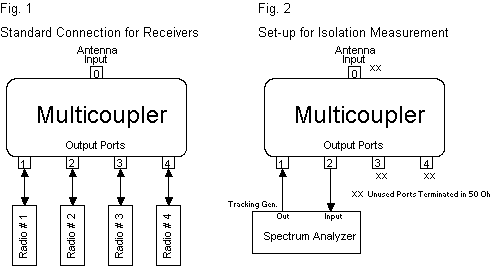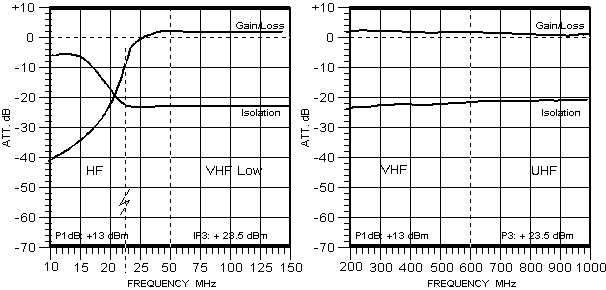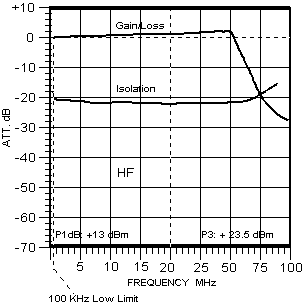

Cage Code: 3RQT1



Send an email to us

STRIDSBERG
Electronics for Radio Surveillance & Monitoring -
Military -





Categories
Multicouplers
Pre-
Receive Filters
Bias-
Accessories


Made In USA

Application and Technical Information
This section of our web site is a tutorial style technical discussion on the application and specification of receiver multicouplers, as well as on support devices such as pre-
The material is mainly from our own R&D, but also from practical field test and experience with receiver multicouplers for a variety of radio monitoring sites.
We expect to include new and useful material for this page on a continuous basis, therefore, it always will stay "Under Construction". If you have a technical or an application question not fully covered here, please email or give us a call, we will be happy to talk to you.
Phone: (318) 861-

Introduction
The most fundamental use of a receiver multicoupler is to enable several radio receivers to utilize a single antenna system without interaction that may degrade each receiver's performance. Many variations in the design concept do exist as well as circuit options, however, signal splitting and the distribution of an RF signal is the basic need to be accomplished.
Receiver multicouplers may be used for all levels of signal monitoring, from VHF/UHF scanner radios used to monitor agencies, HF receivers to monitor shortwave broadcasts or utility stations, etc. The implementation of a monitoring system using multicouplers, from HF to VHF/UHF, may range from the level of the serious hobbyist to surveillance professionals engaged in the business of signals intercept and communications monitoring. There are many benefits in using receiver multicouplers but the most obvious one is, of course, that only one antenna system is required to feed several receivers. The inherent technical layout of the monitoring system is further simplified in that only one feed-
Receiver multicouplers are available in two basic categories, the Passive and Active versions. Both will perform the basic task of splitting an RF signal and feeding several radios without degrading performance of each receiver in the system. The primary difference between a Passive and an Active unit is in how signal losses due to signal splitting is corrected for. That is, normal signal losses always occur in a passive coupler -
In the "Technical Notes" section that follows, we will discuss specifications and common applications of the Receiver Multicoupler. It will be helpful in the selection of a specific unit and demonstrate what a receiver multicoupler can or can not do.
We know that each monitoring site has different technical and operational needs, from a few scanners at a home based monitoring post, to, 32 receiver SIGINT platforms (or something in-

Specifications
For the majority of of users, specifications of importance are port-

Figure 1 above shows how a standard multi-
In figure 2., one method of isolation measurement is shown. This set-
There are, of course, several other electrical and mechanical specification that will determine the performance of a receiver multicoupler, both passive and active models. Among them is signal gain and or loss, signal phase shift (input/output), strong signal handling, power supply requirement, enclosure shielding, etc. Contact Stridsberg Engineering for information on these specifications as it applies to a specific model, or, if they are important or relevant to your specific application.
As mentioned above, in most radio receiving applications using multicouplers, the isolation (rated in dB) is by far the primary parameter of outmost importance. Good isolation will enable multiple receivers to work to its sensitivity specifications, and in the case of scanning radios, not "lock up" on signals emitted from other radios on the same antenna.
Typical Gain & Isolation
MCA102M / MCA104M / MCA108M

Typical Gain & Isolation
MCA202M / MCA204M / MCA208M
Passive vs. Active


Passive vs. Active? In the selection process of a receiver multicoupler the question of whether or not a passive unit can do the job, or, if an active coupler must be used, will have to be answered. In most cases it is relatively easy and straight forward to determine the best choice for a given monitoring site as it is, generally, a question of RF signal strength (or anticipated signal strength) of the transmitters being monitored. For example, if strong HF broadcast stations are primarily monitored, such as BBC, VOA and other international radio stations with substantial signal strength, a passive multicoupler will in most cases do a fine job. Specifically if a large antenna system is used, the passive coupler may be a good choice. If, on the other hand, weaker signals with varying strengths such as those that may be received from clandestine radio transmitters, or from utility stations, is the primary goal of the monitoring effort, an active receiver multicoupler is the better choice.
Stridsberg Engineering offer passive units for both HF and VHF/UHF with up to 4-
On VHF and UHF frequencies, the active multicoupler is the best choice in most cases. Here, the signal strengths of received signals are, generally, lower than what would be encountered on the HF frequencies. Also, increased losses in the antenna feed-
An active receiver multicouplers for VHF/UHF monitoring such as the MCA202M, MCA204M, MCA208M and MCA216M is capable of delivering RF signals to any of the output ports without loss. The frequency coverage of these units range from 25 MHz to 1 GHz, and beyond with slightly relaxed specifications. In fact, the active couplers are useable up to about 1.2 GHz. They are designed with internal amplifiers that corrects for losses, in addition to high-
For HF monitoring, models MCA102M, MCA104M and MCA108M are active receiver multicoupler suitable for continuos service from about 100 kHz to 50 MHz. The high end of the frequency coverage (50 MHz) is set by a low-

Power Supply
All active multicouplers requires +12 VDC/100 mA (nominal) to operate. Because of internal voltage regulation and filtering, this input DC voltage may be between +10 volt and +17 volts. On our standard models, DC power is applied via a common coaxial style power jack (5.5mm/2.1mm) with the center pin positive.
For the North American market, a wall adapter (110VAC/12VDC) is supplied as an accessory. For other countries, using AC power standards of 220 Volts, a DC power plug is supplied for the DC connection, this plug must wired by customer. On request, we can supply this plug wired with about 6 feet of cable for connection to customer +12 VDC power source.
The MCA series of multicouplers are designed to be used in mobile applications as well (surveillance vans, aircraft and shipboard SIGINT/COMINT platforms). If +12 VDC power is available, the multicoupler may be used with the supplied DC plug.For other special DC power requirements, please contact us via phone or email.


Stridsberg Engineering, LLC
354 Albert Avenue
Shreveport, LA 71105, USA
DoD cage Code: 3RQT1
Phone: (318) 861-
Last modified: September -
December 2020